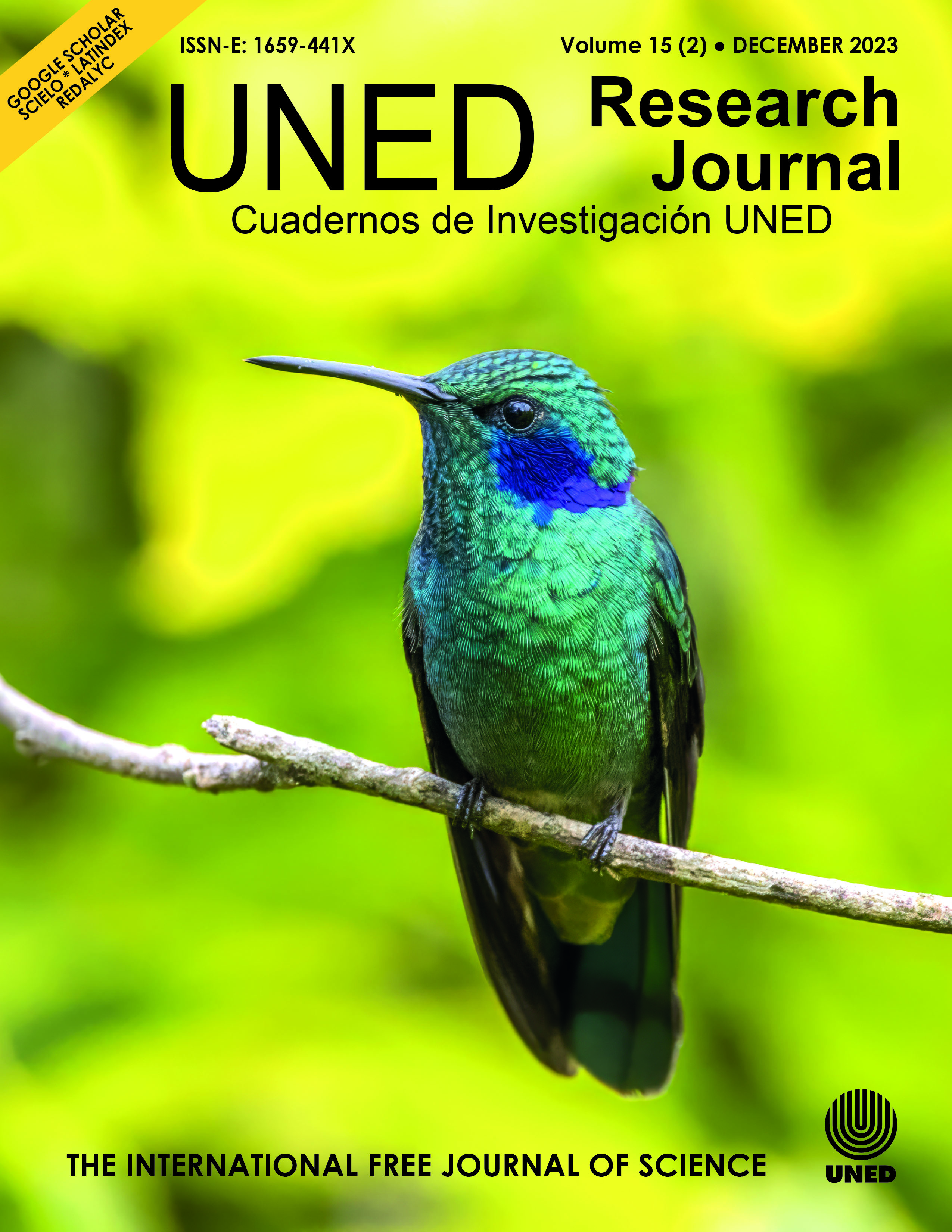First record for Costa Rica of the bat Artibeus inopinatus (Chiroptera: Phyllostomidae)
DOI:
https://doi.org/10.22458/urj.v15i2.4787Keywords:
Uropatagium, hairs, extinction, monitoring, Heritage SiteAbstract
Introduction: The range of the the Honduran fruit bat, Artibeus inopinatus, extends in the south to Nicaragua and there were no previous records of its presence in Guanacaste, Costa Rica, which is the southern limit of the tropical dry forest in Central America. Objective: To record the presence of A. inopinatus in Costa Rica. Methods: In May 2023, we did a mist netting session in Playa Naranjo, Santa Rosa. Results: We captured a pregnant female. Conclusion: Our finding extends the southern distribution of A. inopinatus into northwest Costa Rica.
References
Blanco, R. (2015). ACG Sitio Patrimonio Mundial. https://tinyurl.com/yonn6x5a
Davis, W., & D. Carter. (1964). A new species of fruit- eating bat (genus Artibeus) from Central America. Proceeding of the Biological Society of Washington, 77, 119-121. https://www.biodiversitylibrary.org/part/45769
Jiménez, A., Sandoval, I., & Sánchez, R. (2023). Área Importante para la Conservación de Murciélagos (AICOM) Santa Rosa, ACG. https://tinyurl.com/2326lxo2
Kraker-Castañeda, C., Perez, S. G. Cajas-Castillo., J. O., & Echeverría-Tello. J. L. (2016). Lista actualizada de los murciélagos (Mammalia, Chiroptera) de Guatemala. Revista Mexicana de Biodiversidad, 87(2), 409-416. https://doi.org/10.1016/j.rmb.2015.10.005
Medina-Fitoria, A. (2014). Murciélagos de Nicaragua—Guía de Campo. Dirección de Biodiversidad. https://tinyurl.com/25o5sz82
Portillo, H. O., Aguirre, Y., & Hernández, J. (2019). Registro de una población del murciélago frutero hondureño (Artibeus inopinatus) (David y Carter, 1964), en Nacaome, Valle, Honduras. Scientia hondurensis, 2(1), 71-75 https://incebio.files.wordpress.com/2020/07/registros_de_una_poblacion_del_murcielag.pdf
Reid, F., & Medina, A. (2016). Artibeus inopinatus. The IUCN Red List of Threatened Species 2016 http://dx.doi.org/10.2305/IUCN.UK.2016-2.RLTS.T2132A21996586.en
Turcios-Casco, M., Ávila-Palma, H., Ordoñez, E., Soler, J., Ordoñez, I., Meza-Flórez, D., & Velásquez, A. (2020). Rare or misidentified? On the external identification of the neglected Artibeus inopinatus Davis & Carter, 1964 (Chiroptera, Phyllostomidae) in Honduras. Evolutionary Systematics, 4(1), 35–43. https://evolsyst.pensoft.net/article/49377/
Solari, S., Medellín, R., Rodríguez-Herrera, B., da Cunha Tavares, V., Garbino, G., Camacho, M., Tirira, D., Lim, B., Arroyo-Cabrales, J., Rodríguez-Durán, A., Dumont, E., Burneo, S., Aguirre, L., Tschapka, M., & Espinosa, D. (2019). Family Phyllostomidae (New World Leaf-nosed Bats). En Wilson, D. y Mittermeier, R. (2019), Phyllostomidae, Handbook of the Mammals of the World – Volume 9 Bats (pp. 444-583: 571). Lynx Editions.
York, H., Rodríguez-Herrera, B., LaVal, R., & Timm, R. (2019). Field key to the bats of Costa Rica and Nicaragua. Journal of Mammalogy, 100(6), 1726–1749. https://core.ac.uk/download/pdf/286336495.pdf
Published
How to Cite
Issue
Section
License
Copyright (c) 2023 UNED Research Journal

This work is licensed under a Creative Commons Attribution 4.0 International License.
Note: This abstract contains an incorrect copyright due to technical issues. Authors who publish with this journal agree to the following terms: Authors retain copyright and grant the journal right of first publication with the work simultaneously licensed under a Creative Commons Attribution License that allows others to share the work with an acknowledgement of the work's authorship and initial publication in this journal
All journal contents are freely available through a CC BY 4.0 license.
CC BY 4.0 is a Creative Commons: you can copy, modify, distribute, and perform, even for commercial reasons, without asking permission, if you give appropriate credit.
Contents can be reproduced if the source and copyright are acknowledged according to the Open Access license CC BY 4.0. Self-storage in preprint servers and repositories is allowed for all versions. We encourage authors to publish raw data and data logs in public repositories and to include the links with all drafts so that reviewers and readers can consult them at any time.
The journal is financed by public funds via Universidad Estatal a Distancia and editorial independence and ethical compliance are guaranteed by the Board of Editors, UNED. We do not publish paid ads or receive funds from companies.




